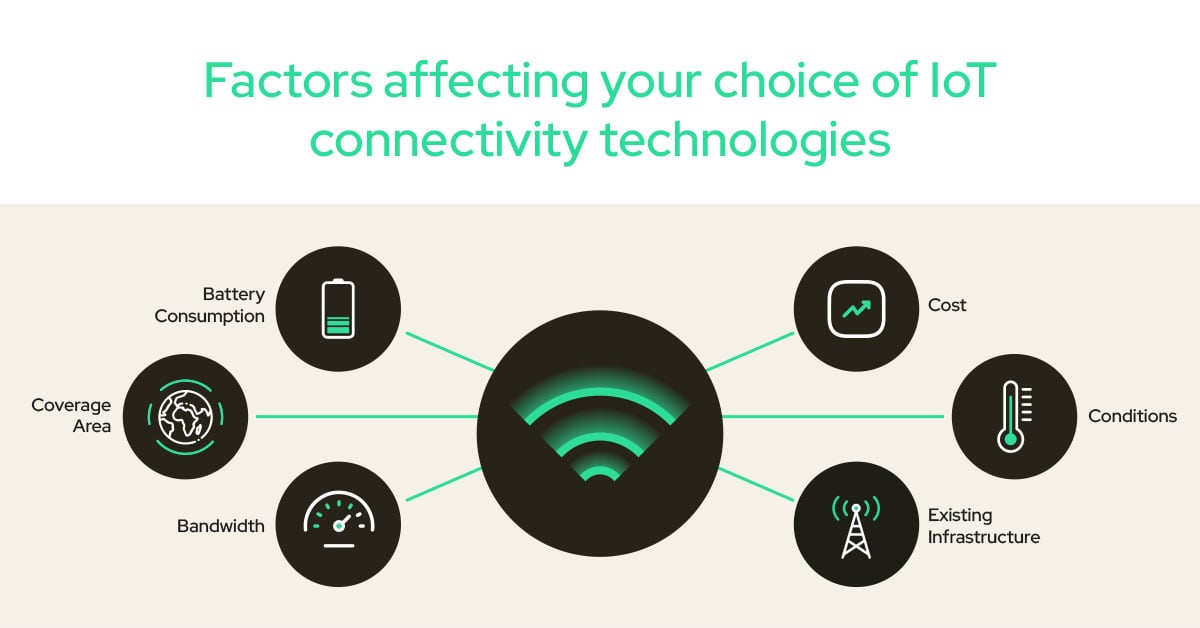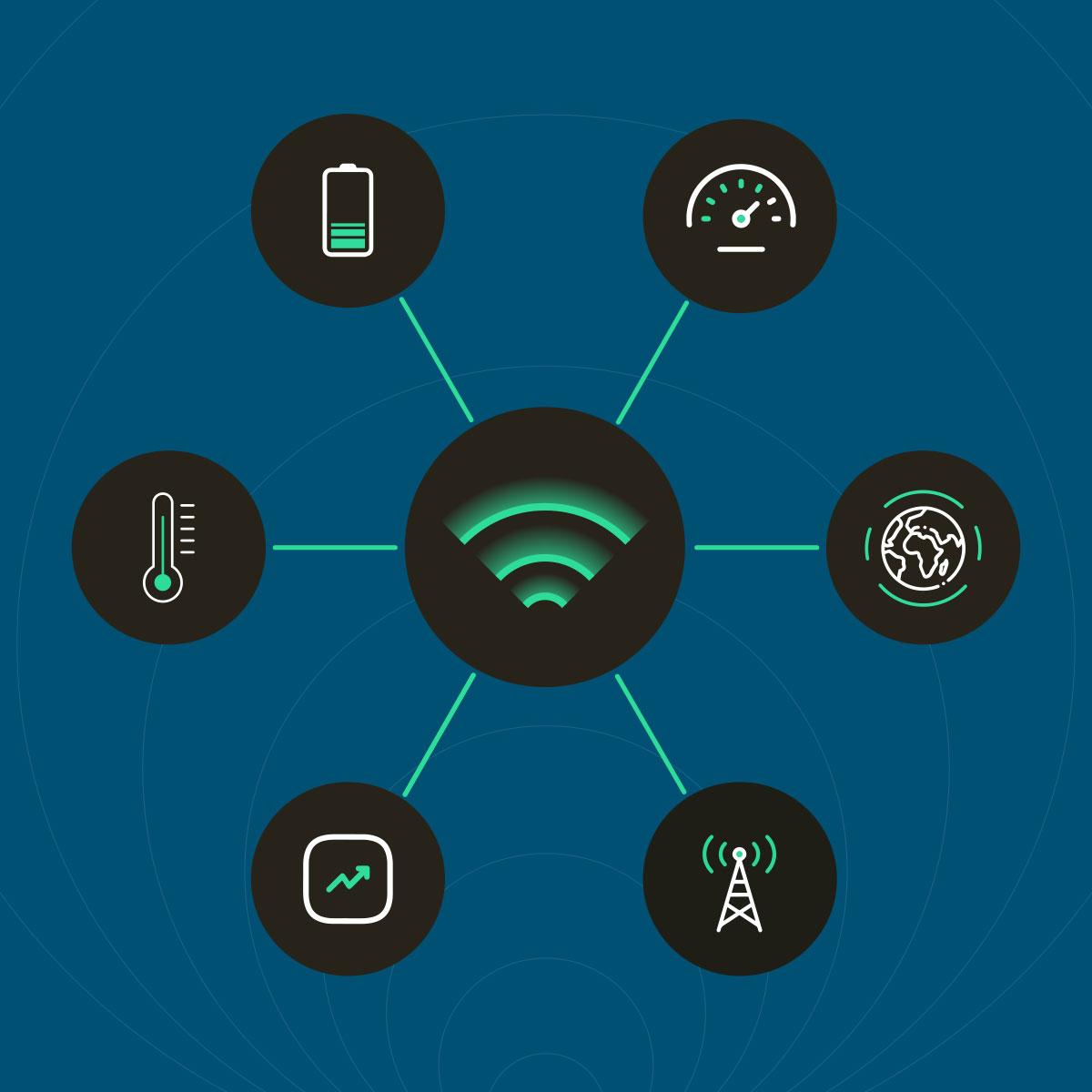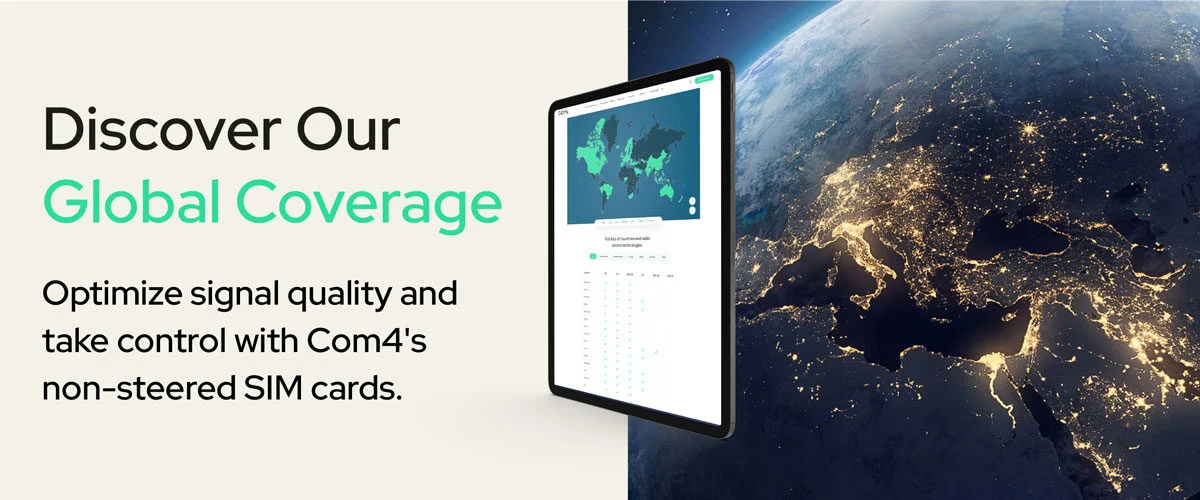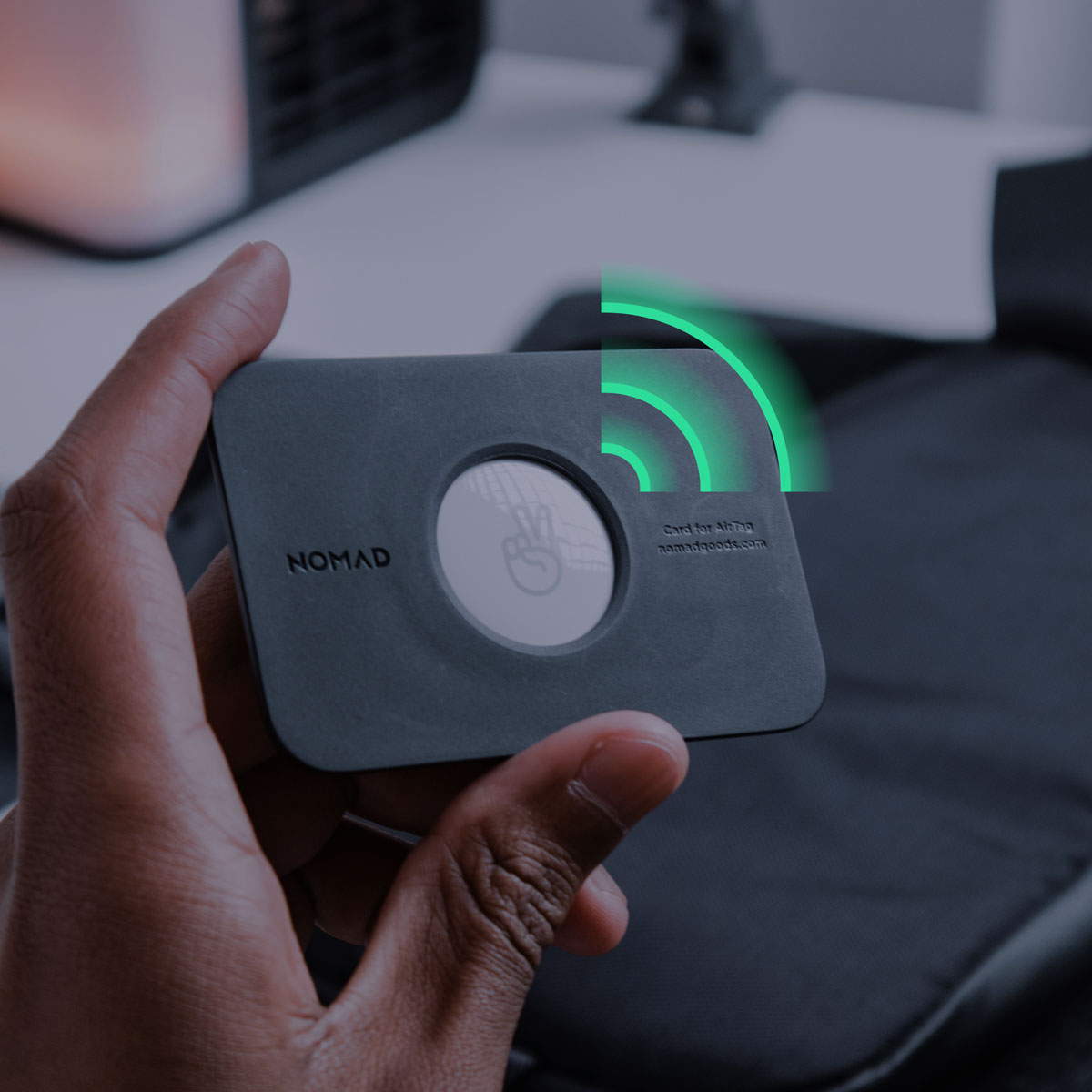There is no universal “best” option. Instead, the right choice depends on your use case, device form factor, and long-term deployment strategy. This guide explores the key factors you should consider when selecting connectivity, with insights from real-world Com4 use cases.
Table of Contents
Device size and constraints
Coverage and deployment area
Power and battery life
Data and throughput requirements
Cost and scalability

Device size and constraints
The physical size of an IoT device often determines which connectivity technologies are feasible. Antenna size, battery capacity, and processing limitations are all influenced by form factor.
Table: Device size vs connectivity options
|
Device size |
LTE-M / NB-IoT |
4G / 5G |
Satellite NTN |
|
Very small (coin-sized) |
Limited |
Not feasible |
Feasible |
|
Pocket-sized (tracker, card) |
Supported |
Possible |
Limited |
|
Larger devices (gateways, meters, tablets) |
Fully supported |
Fully supported |
Supported |
Com4 supports eSIM and iSIM solutions, enabling even compact devices to connect flexibly across multiple networks without physical SIM swaps.
Use case: Soundsensing relies on Com4 LTE-M connectivity for compact noise monitoring sensors used in real estate. The small form factor requires efficient connectivity without sacrificing performance in dense urban environments.
Coverage and deployment area
Coverage is often the deciding factor for global IoT projects. Connectivity needs vary depending on whether deployments are urban, rural, or remote.
Table: Coverage comparison
|
Technology |
Urban coverage |
Rural coverage |
Global reach |
Mobility suitability |
|
NB-IoT |
Good indoors (market dependent) |
Reliable |
Global Standard, but has fewer roaming implementations compared to other mobile technologies. |
Good for mobile devices |
|
LTE-M |
Good indoors |
Reliable |
Global via roaming |
Designed for mobility |
|
4G / 5G |
Excellent |
Excellent |
Global via roaming |
Excellent |
|
Satellite |
Limited indoors |
Excellent remote and offshore |
Global |
Excellent outdoors |
Com4 delivers truly global connectivity for IoT devices by combining extensive terrestrial and satellite coverage. Through partnerships with more than 750 cellular networks across over 190 countries, Com4 ensures reliable, secure, and cost-efficient IoT communication wherever your devices operate. For remote or hard-to-reach regions where traditional terrestrial networks are unavailable, Com4 extends its reach with Satellite NTN services, enabling seamless global coverage and enhanced security for mission-critical operations.
Built on advanced SIM technology, including eSIMs and iSIMs integrated directly into the system on chip (SoC) or circuit board, Com4 connectivity supports smaller devices and optimized power consumption without relying on traditional physical SIM cards. These embedded SIMs act as a tamper-resistant element, a type of secure enclave within the device’s operating system, ensuring data integrity and privacy across all form factors, from industrial sensors to smartphones and tablets. The benefits of iSIM include lower costs, improved efficiency, and scalable cost savings, making Com4 an ideal partner for secure, future-ready IoT connectivity.
Use case: Gridguard uses Com4 connectivity to monitor and protect power infrastructure across rural and hard-to-reach sites, ensuring reliable service where terrestrial coverage is limited.
Power and battery life
Battery-powered devices require efficient connectivity to maximize lifetime. While NB-IoT is often marketed as the most power-efficient option, real-world testing shows that LTE-M achieves comparable or even better efficiency, particularly when GPS assistance is required.
Use case: Smart city projects powered by Com4 LTE-M connectivity operate for 10+ years on a single battery, transmitting environmental data without compromising device life cycle.
Data and throughput requirements
Connectivity choice should reflect the data profile of the application.
Table: Payload and update rates
|
Connectivity |
Typical payload size |
OTA firmware updates possible |
|
NB-IoT |
Small |
Limited |
|
LTE-M |
Medium |
Yes |
|
4G / 5G |
Large |
Yes |
|
Satellite NTN |
Extra Small |
Limited |
For applications requiring regular firmware updates, higher payloads, or real-time data, LTE-M, 4G, and 5G provide the most robust options.
Use case: A company deploys Com4 SIMs in connected tablets across shopping centers to collect customer insights. The higher throughput requirement is met with reliable cellular connectivity and centralized data management.
Cost and scalability
The total cost of ownership for IoT connectivity includes hardware, SIM cards, roaming, platform fees, and long-term administration.
Table: Approximate connectivity costs (5-year horizon)
|
Technology |
Average monthly cost (per device) |
Suitable for |
|
NB-IoT |
Low |
Static, single-market deployments |
|
LTE-M |
Moderate |
Global, mobile, low-power use cases |
|
4G / 5G |
Higher |
High-throughput, global projects |
|
Satellite |
Variable |
Remote and maritime deployments |
 Com4 offers transparent pricing and flexible data plans, with advanced control via our Connectivity Management Platform (CMP). This ensures customers can scale globally, optimize data usage, and avoid hidden costs.
Com4 offers transparent pricing and flexible data plans, with advanced control via our Connectivity Management Platform (CMP). This ensures customers can scale globally, optimize data usage, and avoid hidden costs.
Use case: Retailers deploying hundreds of tablets in shopping centers use Com4 pooling plans to control costs across thousands of SIMs, ensuring predictable expenditure at scale.
There is no single answer to “the best” IoT connectivity. The decision depends on size, coverage, power, data profile, and cost. Com4 provides a modular technology stack to meet these diverse needs:
- Cellular IoT: LTE-M, NB-IoT, 4G, 5G with 2G fallback.
- Future-ready eSIM and iSIM solutions.
- Satellite IoT with NTN.
- Com4 Connectivity Management Platform for full visibility and control.
By combining cellular and satellite technologies with advanced management tools, Com4 ensures your devices stay online: whether in a city basement, on a rural power line, or in the middle of the ocean.
FAQs
How does device size affect connectivity choice?
Smaller devices, such as trackers or sensors, have limited space for antennas and batteries. Technologies like LTE-M and NB-IoT are ideal for compact, low-power devices.
Larger devices, including gateways or tablets, can support 4G or 5G.
Example: Soundsensing uses Com4’s LTE-M connectivity for compact noise monitoring sensors used in real estate.
Which IoT connectivity offers the best coverage?
Coverage depends on deployment location:
- NB-IoT / LTE-M: strong for urban and rural environments.
- 4G / 5G: best for high-speed global mobility.
- Satellite (NTN): ideal for remote or offshore areas with no terrestrial coverage.
Com4 combines over 750 mobile networks in 190+ countries with satellite coverage, ensuring global reach for any IoT project.
Which technology is most power-efficient for battery-powered IoT devices?
Both NB-IoT and LTE-M offer low-power consumption. However, in real-world use, LTE-M often performs better when GPS or higher mobility is required.
What connectivity is best for devices that send large amounts of data?
For high data throughput, real-time communication, or firmware updates, LTE-M, 4G, and 5G are the best choices.
NB-IoT and Satellite NTN are better suited for devices transmitting smaller amounts of data less frequently.
How do costs compare between different IoT connectivity types?
Approximate cost levels over a 5-year period:
- NB-IoT: low — suitable for static, single-market devices.
- LTE-M: moderate — suited for global, mobile, or low-power use cases.
- 4G/5G: higher — ideal for high-throughput and real-time applications
- Satellite: variable — used for maritime or remote deployments.
Com4’s Connectivity Management Platform (CMP) provides transparent pricing, global scalability, and real-time control over data usage.
What if my devices operate in both urban and remote locations?
Com4 provides hybrid cellular and satellite IoT solutions, ensuring seamless connectivity wherever devices are deployed — from city basements to offshore platforms. This eliminates coverage gaps and maintains reliable operation worldwide.
Does Com4 support eSIM and iSIM for flexible connectivity?
Yes. Com4 supports both eSIM and iSIM, allowing devices to switch networks remotely without physical SIM swaps. This enables flexibility, simplified logistics, and scalability for global IoT projects.
How can I manage and monitor my IoT connectivity?
Com4’s Connectivity Management Platform (CMP) provides full visibility and control of all SIMs across cellular and satellite networks. It allows users to monitor data usage, manage activations, and optimize costs efficiently.











